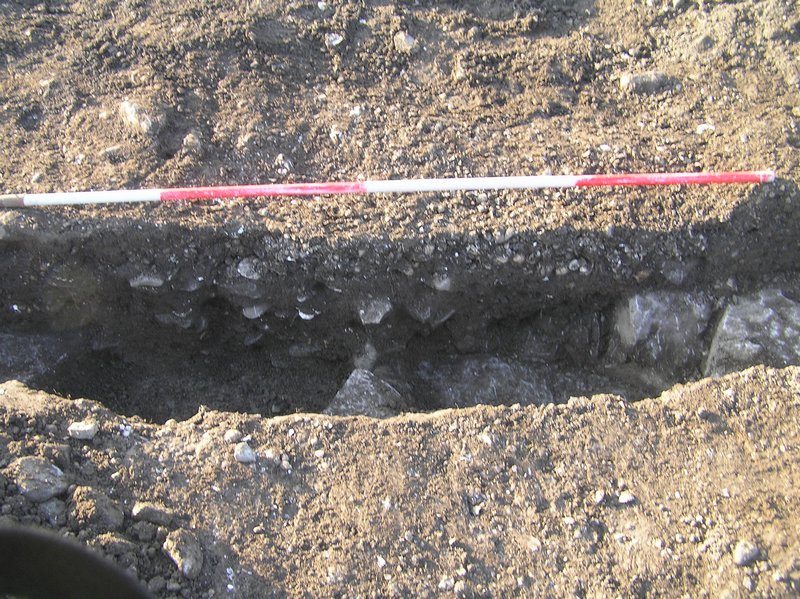COCKLES AND PISEOG’S
Area 2 at Oranmore comprised a recent midden (basically a 19th century dump) and didn’t contain anything of any great significance – mostly oyster shells etc.. The stratigraphy of the midden revealed that the deposited shells were located immediately below the sod, and rested above the sub-soil, which in turn was sitting on glacial till. During the excavation of this slot trench 19th century glass was recovered from the subsoil below the midden layer, indicating the midden material was deposited recently in the 19th or 20th century.

Trench through midden
Ger analysed the shell and his description follows..
Generally, there are two types of mollusc present in the samples analysed, marine molluscs and non-marine or land snails. The land snails are naturally occurring and could be considered part of the natural fauna of the area. The marine molluscs were harvested for food and the shells discarded thereafter. The majority of the shell recovered during excavations was Oyster shell, with some complete valves, but mostly broken and worn portions. The fragmented and worn nature of the shell portions made analysis of animal numbers impossible.
The use of oyster as a popular food dates from prehistoric times, reflected in the composition of shell middens around the coast of Ireland. Oyster farming from beds on the coasts of France and the UK have been used since Roman times.
The native oyster Ostrea edulis is associated with highly productive estuarine and shallow coastal water habitats on firm bottoms of mud, rocks, muddy sand, muddy gravel with shells and hard silt. In exploited areas, suitable habitat has been created in the form of ‘cultch’ – broken shells and other hard substrata.

Oysters – Photo CC from http://www.flickr.com/photos/clairity/
Ostrea edulis is a bivalve mollusc that has an oval or pear-shaped shell with a rough, scaly surface. The two halves (valves) of the shell are different shapes. The left valve is concave and fixed to the substratum, the right being flat and sitting inside the left. The shell is off-white, yellowish or cream in colour with light brown or bluish concentric bands on the right valve. Ostrea edulis grows up to 110mm long, rarely larger. The inner surfaces are pearly, white or bluish-grey, often with darker blue areas.
The first recorded taxation of oysters [in Ireland] is a report of the payment to the Revenue Receiver of Old Ross of six shillings and eight pence by Philip Bentee in 1281 for oyster beds (“pro terras ostredan”) in Wexford Harbour. So popular were oysters that many towns had ordinances protecting their local supply from outsiders. In 1734 Youghal Corporation agreed with its lessee Nicol Giles a fixed price of 16 pence per hundred oysters on the condition “…that he obliged to supply the town with the same and not sell more than half a hundred to one person at once, until oysters are more plenty” (Wilkins, 2004).
Common cockle Cerastoderma edule are widely distributed in estuaries and sandy bays around the coasts of Britain and Ireland. They inhabit the surface of sediments, burrowing to a depth of no more than 5cm. They are found on clean sand, muddy sand, mud or muddy gravel from the middle to lower intertidal, sometimes subtidally. Cockles were also a popular food source, however, not so much as oyster. It may be that the meat of these species was poorly regarded or possibly that the lower numbers are related to a Gaelic Irish sexual piseog that these species, when actively feeding (i.e. when open) bear a superficial resemblance to female exterior genitalia and thus until relatively recent times have been considered inappropriate for normal consumption (Wilkins, 2001). It is more likely that cockles were an incidental by catch in the harvesting of Oysters.
For a full list of references email us…
This entry was posted on Monday, February 14th, 2011 at 12:31 pm. It is filed under About Archaeology and tagged with Archaeological excavation, Archaeologist, galway, Oranmore.
You can follow any responses to this entry through the RSS 2.0 feed.






